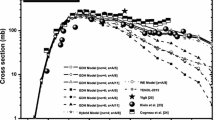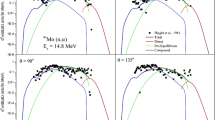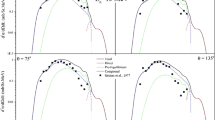Abstract
The growing demands for energy consumption have led to the increase of the research and development activities on new energy sources. Fusion energy has the highest potential to become a very safe, clean and abundant energy source for the future. To get energy from fusion are needed for development of fusion reactor technology. Particularly, the design and development of international facilities as International Thermonuclear Experimental Reactor and International Fusion Material Irradiation Facility requires for the cross-section data of deuteron induced reactions. Moreover, the selection of fusion structural materials are an indispensable component for this technology. Therefore, the cross-section data of deuteron induced reactions on fusion structural materials are of great importance for development of fusion reactor technology. In this study, reaction model calculations of the cross sections of deuteron induced reactions on structural fusion materials such as 27Al, 59Co, 55Mn, 50Cr, 54Cr, 64Ni, 109Ag, 184W and 186W have been carried out for incident energies up to 50 MeV. In these calculations, the pre-equilibrium and equilibrium effects for (d,p) stripping reactions have been investigated. The pre-equilibrium calculations involve the new evaluated the geometry dependent hybrid model and hybrid model. Equilibrium effects are calculated according to the Weisskopf-Ewing model. In the calculations the program code ALICE/ASH was used. The calculated results are discussed and compared with the experimental data taken from the literature.
Similar content being viewed by others
Avoid common mistakes on your manuscript.
Introduction
Nuclear fusion has great potential as a sustainable energy source. Moreover, it can be one of the most attractive sources of energy from the viewpoint of safety and minimal environmental impact. There is an essentially unlimited fuel supply, deuterium from the ocean and tritium from transmutation of lithium using neutrons produced in the D–T fusion reaction. Fusion will not contribute to global warming, acid rain or other forms air pollution since it will not produce SO2 or CO2 [1]. Additionally, there are not radioactive nuclear waste problems in the fusion reactors. In the fusion–fission hybrid reactor, tritium self-sufficiency must be maintained for a commercial power plant. For self-sustaining (D–T) fusion driver tritium breeding ratio should be greater than 1.05 [2–5]. Fusion powered electricity generation was initially believed to be readily achievable, as fission power had been. However, the extreme requirements for continuous reactions and plasma containment led to projections being extended by several decades. In 2010, more than 60 years after the first attempts, commercial power production is still believed to be unlikely before 2050. Moreover, the success of fusion reactors is seriously dependent on performance, lifetime of the first wall, blanket or divertor systems. The performance and design of these components for fusion reactor are dependent on the properties of the structural materials. Thus, the selection of structural materials is one of the most important issues of fusion technology [6–8]. Aluminum (Al), Cobalt (C), Manganese (Mn), Chromium (Cr), Nickel (Ni), Silver (Ag) and Wolfram (W) containing alloys are important structural materials for fusion reactors. Aluminum is among the most appealing materials for fusion reactors due to its high strength to weight ratio and relatively low activation rate [9]. Wolfram is more preferable in future breeders due to low activation property. Nickel alloys play an important part in maintaining the resistance and long term performance of fusion reactors. And also, they are required for the fusion chamber. Cobalt-based alloys are used as structural materials for fusion reactors due to the high strength and hardness properties. Manganese and chromium steels are important structural materials as low activation materials for fusion reactors [10].
The nuclear cross sections data for gas production via particle (neutron, proton, alpha, deuteron, etc.) induced reactions are great importance in the domain in the fusion reactor technology. In fusion reactor structures, a serious damage mechanism has been gas production in the metallic resulting from diverse nuclear reactions, mainly through (n,p) and (n,α), (n,d), (n,t) and to some extent through (p,n), (p,p), (p,α), (α,n), (d,p) reactions above a certain threshold energy. The hydrogen isotopes will diffuse out of the metallic lattice under high operation temperatures. Especially, the deuteron induced reactions can be complexity due to small binding energy and large average separation of the deuteron consists of one proton and one neutron. The cross section data for deuteron induced reactions are scarce, so that improved model calculations are needed. This cross section data can reduce engineering over design costs. It can lead to design of the target blanket configurations. And also, design and development of international facilities as International Thermonuclear Experimental Reactor (ITER) and International Fusion Material Irradiation Facility (IFMIF) requires for the cross-section data of deuteron induced reactions [11–13].
This work aims to provide the cross section of some nuclear reactions induced by deuterons with incident energies up to 50 MeV. 27Al, 59Co, 55Mn, 50Cr, 54Cr, 64Ni, 109Ag, 184W and 186W target nuclei are investigated for (d,p) reactions. The pre-equilibrium results were newly calculated by using the hybrid model and the geometry dependent hybrid (GDH) model [14]. The reaction equilibrium component was calculated with a traditional compound nucleus model developed by Weisskopf-Ewing (WE) [15]. The calculated results have been discussed and compared with the available measurements in literature.
Equilibrium Model Calculations
It is known that in the energy region below 10 MeV, compound nuclear processes dominate. The equilibrium particle emission is described by the Weisskopf-Ewing (WE) Model [15] in which angular momentum conservation is neglected. In the process, the basic parameters are binding energies, inverse reaction cross-section, the pairing and the level-density parameters. The reaction cross-section for incident channel a and exit channel b can be written as;
where E inc is incident energy, \( \Upgamma_{b} \, = \, \frac{{2{\text{ s}}_{b} \, + \, 1}}{{\pi^{2} \, \hbar^{2} }} \, \mu_{b} \, \int {{\text{d}}\varepsilon \, \sigma_{b}^{inv} (\varepsilon \, )} \, \varepsilon \, \frac{{\omega_{1} (U)}}{{\omega_{1} (E)}} \), U is the excitation energy of the residual nucleus, s b is the spin, μ b is reduced mass and the total single-particle level density is taken as,
where σ inv b is the inverse reaction cross-section, D is the pairing energy, g is the single particle level density and E is the excitation energy of the compound nucleus.
Pre-Compound Hybrid and Geometry Dependent Hybrid Model Calculations
The mechanism of a nuclear reaction depends on the energy of incident particle. Pre-equilibrium processes play a significant role in nuclear reactions induced by light projectiles with incident energies above about 8–10 MeV. The pre-equilibrium reactions take place in a number of steps, corresponding to the excitation of successive particle-hole pairs by the interaction of the incident particle with target nucleus. At each stage, either a particle is emitted or statistical equilibrium is reached [16]. For pre-equilibrium calculations, the hybrid model was first described by Blann [17, 18],
where σ R is the reaction cross section, \( {}_{n}\chi {}_{\nu } \) is the number of particle type ν (proton or neutron) in n exciton hierarchy, g ν is the single particle level density for particle type ν, \( P_{\upsilon } (\varepsilon )d\varepsilon \) represents number of particles of the type ν emitted into the unbound continuum with channel energy between ε and ε + dε. The quantity in the first set of square brackets of Eq. (4) represents the number of particles to be found (per MeV) at a given energy ε for all scattering processes leading to an “n” exciton configuration. \( \lambda_{c} (\varepsilon ) \) is emission rate of a particle into the continuum with channel energy ε and \( \lambda_{ + } (\varepsilon ) \) is the intranuclear transition rate of a particle. The second set of square brackets in Eq. (4) represents the fraction of the ν type particles at a energy which should undergo emission into the continuum, rather than making an intranuclear transition. The D n represents the average fraction of the initial population surviving to the exciton number being treated. U is the residual nucleus excitation energy, E is the composite system excitation energy (U = E − B ν − ε, where the B ν is the particle binding energy and N n (ε, U) is the number of ways.
The geometry dependent hybrid model (GDH) is a version of the hybrid model considered nuclear geometry effects. It takes into consideration the reduced matter density and thus also the shallow potential at the nuclear surface [18]. The diffused surface properties sampled by higher impact parameters were crudely incorporated into the pre-compound decay formation in the geometry dependent hybrid model (GDH). The differential emission spectrum is given in the geometry dependent hybrid model (GDH) is given by,
where \( \mathchar'26\mkern-10mu\lambda \) is the reduced de Broglie wavelength of the projectile and \( T_{\ell } \) represents transmission coefficient for \( \ell \)-th partial wave. The geometry dependent hybrid model (GDH) is made according to incoming orbital angular momentum \( \ell \) in order to account for the effects of the nuclear-density distribution. This leads to increased emission from the surface region of the nucleus, and thus to increased emission of high-energetic particles.
Results and Discussions
In the calculations the code ALICE/ASH has been used [14]. This code can be applied for the calculation of excitation functions, energy and angular distribution of secondary particles in nuclear reactions induced by nucleons and nuclei with the energy up to 300 MeV. The ALICE/ASH code is a modified and improved version with additional physics, corrections and capabilities of the ALICE code. The generalized superfluid [19] has been applied for nuclear level density calculations in the ALICE/ASH code. In ALICE/ASH code, the hybrid model and the geometry dependent hybrid model (GDH) for pre-equilibrium process, the Weisskopf-Ewing model for equilibrium process are selected. The exciton includes the particle and the hole in the nucleus. We used the initial exciton number n0 = 4. And also, were assumed that the initial excited neutron number and the initial excited proton number to be 0.1, 2.9, respectively. In details, the other code model parameters can be found in Ref. [14].
In this study, (d,p) stripping reaction cross sections for some structural fusion materials as 27Al(d,p)28Al, 50Cr(d,p)51Cr, 54Cr(d,p)55Cr, 55Mn(d,p)56Mn, 59Co(d,p)60Co, 64Ni(d,p)65Ni, 109Ag(d,p)110Ag, 184W(d,p)185W and 186W(d,p)187W have been calculated with the equilibrium and pre-equilibrium reaction models in Figs. 1, 2, 3, 4, 5, 6, 7, 8 and 9. The hybrid and geometry dependent hybrid model calculations have approximately the same cross section for the considered nuclei. Calculated (d,p) cross sections by using ALICE/ASH code for the equilibrium with Weisskopf-Ewing model calculations are in agreement with the experimental data at the low energy region up to 10 MeV. But, the size difference between experimental data and equilibrium calculations increase especially with increasing of energy. Above 10 MeV, the Weisskopf-Ewing model can not correctly calculate emission spectra. In Weisskopf-Ewing model, compound nucleus wave function is very complex, including a large number of particle-hole excitations to which statistical considerations are suitable, the spectra of the emitted particles are approximately Maxwellian, and the angular distributions of emitted particles are symmetric about 90 degrees. Except the Wolfram (184,185W) target nuclei, the pre-equilibrium model calculations with the hybrid and geometry dependent hybrid model (GDH) are generally in excellent agreement with the experimental data on (d,p) reactions for all target nuclei. The all model calculations are lower than the experimental data for the Wolfram (184,185W) target nuclei. The values of (d,p) experimental and theoretical cross-sections appear to give maximum value about incident deuteron energy 5–15 MeV. The pre-equilibrium model calculations and experimental data are almost constant above 10 MeV. It can be said that, at least this study contributes to the new studies on cross section and help to show the way to the future experimental studies.
The comparison of calculated excitation function of 27Al(d,p)28Al reaction with the values reported in Ref. [20]
The comparison of calculated excitation function of 50Cr(d,p)51Cr reaction with the values reported in Ref. [20]
The comparison of calculated excitation function of 54Cr(d,p)55Cr reaction with the values reported in Ref. [20]
The comparison of calculated excitation function of 55Mn(d,p)56Mn reaction with the values reported in Ref. [20]
The comparison of calculated excitation function of 59Co(d,p)60Co reaction with the values reported in Ref. [20]
The comparison of calculated excitation function of 64Ni(d,p)65Ni reaction with the values reported in Ref. [20]
The comparison of calculated excitation function of 109Ag(d,p)110Ag reaction with the values reported in Ref. [20]
The comparison of calculated excitation function of 184W(d,p)185W reaction with the values reported in Ref. [20]
The comparison of calculated excitation function of 186W(d,p)187W reaction with the values reported in Ref. [20]
Summary and Conclusions
In this study, (d,p) stripping reactions for some structural fusion materials as 27Al, 59Co, 55Mn, 50Cr, 54Cr, 64Ni, 109Ag, 184W and 186W have been investigated up to 50 MeV incident deuteron energy. The available experimental data in literature and the theoretical data obtained in this work are plotted in Figs. 1, 2, 3, 4, 5, 6, 7, 8 and 9 as a function of incident deuteron energy. The results can be summarized and concluded as follows:
-
1.
Except the Wolfram target nuclei, the calculations of pre-equilibrium process show generally the excellent agreement with experimental data for all nuclei used in this study.
-
2.
The all model calculations are lower than the experimental data for the Wolfram target nuclei.
-
3.
The size difference between experimental data and equilibrium calculations increase especially with increasing of energy.
-
4.
The values of (d,p) experimental and theoretical cross-sections appear to give maximum value about incident deuteron energy 5–15 MeV.
-
5.
The pre-equilibrium model calculations and experimental data are almost constant above 10 MeV.
References
E.E. Bloom, J. Nucl. Mater. 7, 258 (1998)
S. Şahin, M. Übeyli, J. Fusion Energ. 27, 271 (2008)
M. Übeyli, E. Tel, J. Fusion Energ. 22, 2 (2003)
E. Tel et al., J. Fusion Energ. 27(3), 188 (2008)
E. Tel et al., J. Fusion Energ. 28, 377 (2009)
W. R. Meier et al., Lawrence Livermore National Laboratory, LLNL-JRNL-416976 (2009)
M. Rubel, Trans. Fusion Sci. Technol. 53, 459 (2008)
E. Tel et al., J. Fusion Energ. 31(2), 194 (2012)
R.K. Smither, L.R. Greenwood, J. Nucl. Mater. 123, 1071 (1984)
G. Piatti, G. Musso, J. Mater. Sci. 21, 2339 (1986)
M. Avrigeanu, V. Avrigeanu, J. Phys. 205, 012014 (2010)
M. Avrigeanu et al., EPJ Web Conf. 21, 07003 (2012)
E. Simeckova et al., Phys. Rev. C 84, 014605 (2011)
C. H. M. Broeders, A.Yu. Konobeyev, Yu.A. Korovin, V.P. Lunev, and M. Blann ALICE/ASH—pre-compound and evaporation model code system for calculation of excitation functions, energy and angular distributions of emitted particles in nuclear reactions at intermediate energies, FZK 7183, May 2006, http://bibliothek.fzk.de/zb/berichte/FZKA7183.pdf
V.F. Weisskopf, D.H. Ewing, Phys. Rev. 57, 472 (1940)
P.E. Hodgson, E. Betak, Phys. Rep. 374, 1–89 (2003)
M. Blann, Phys. Rev. Lett. 27, 337 (1971)
M. Blann, H.K. Vonach, Phys. Rev. C 28, 1475 (1983)
A.V. Ignatyuk, K.K. Istekov, G.N. Smirenkin, Yad. Fiz. 29, 875 (1979)
Brookhaven National Laboratory, National Nuclear Data Center, EXFOR/CSISRS (Experimental Nuclear Reaction Data File). Database version of October 12, 2009, (http://www.nndc.bnl.gov/exfor/) (2009)
Author information
Authors and Affiliations
Corresponding author
Rights and permissions
About this article
Cite this article
Yiğit, M., Tel, E. & Tanır, G. Calculations of Proton Emission Cross Sections in Deuteron Induced Reactions of Some Fusion Structural Materials. J Fusion Energ 32, 317–321 (2013). https://doi.org/10.1007/s10894-012-9569-6
Published:
Issue Date:
DOI: https://doi.org/10.1007/s10894-012-9569-6













